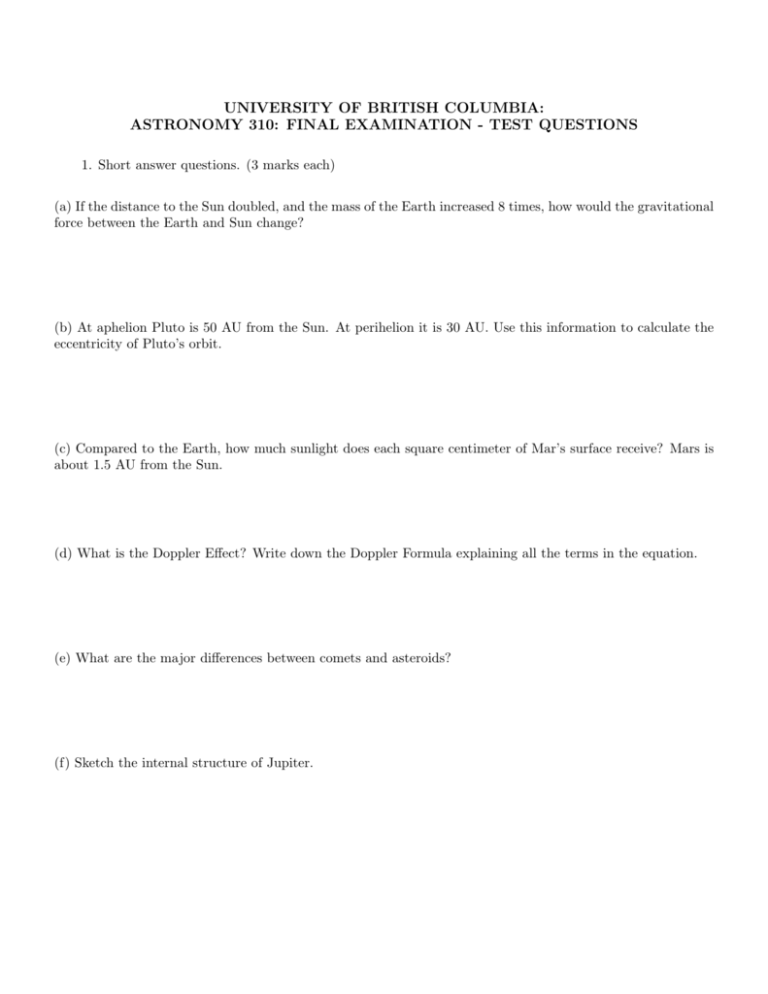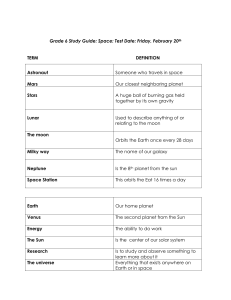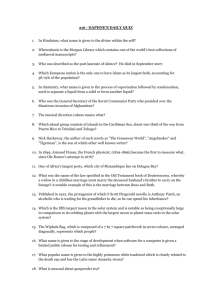astronomy 310: final examination - test questions
advertisement

UNIVERSITY OF BRITISH COLUMBIA: ASTRONOMY 310: FINAL EXAMINATION - TEST QUESTIONS 1. Short answer questions. (3 marks each) (a) If the distance to the Sun doubled, and the mass of the Earth increased 8 times, how would the gravitational force between the Earth and Sun change? (b) At aphelion Pluto is 50 AU from the Sun. At perihelion it is 30 AU. Use this information to calculate the eccentricity of Pluto’s orbit. (c) Compared to the Earth, how much sunlight does each square centimeter of Mar’s surface receive? Mars is about 1.5 AU from the Sun. (d) What is the Doppler Effect? Write down the Doppler Formula explaining all the terms in the equation. (e) What are the major differences between comets and asteroids? (f) Sketch the internal structure of Jupiter. –2– (g) What time does (α) the waxing gibbous Moon set? (β) the last quarter Moon reach highest in the sky? (h) In point form list the likely effects of the collision of a large asteroid with the Earth. 2. Name that planet or moon!! (1 mark each) There used to be a game show called “Name That Tune”. Here we adapt that concept to ASTR 310 and play “Name That Planet or Moon”. The rules — name the planet or moon associated with each description. A given planet or moon should be used only once in answering these questions. (a) the planet that has about the same cratering density as the Moon (b) the only planet that would float in an ocean big enough to hold it (c) the planet whose appearance is blue due to absorption of sunlight by methane (d) the planet that has experienced a “Run-Away Greenhouse Effect” (e) the planet containing the largest volcanoes in the Solar System (f) the planet whose distance from the Sun is 1 AU 3. Somewhat longer, more detailed questions. (5 marks each) (a) Sketch the interior structure of the Earth. Indicate briefly how it was determined. (b) [For those who love calculations.] (i) Imagine that a new comet has been discovered and that studies of its motion indicate that it orbits the Sun with a period of 1,000 years. What is the comet’s average distance (semi-major axis) from the Sun? (ii) Imagine another solar system, with a star of the same mass as the Sun. Suppose there is a planet in that solar system with a mass twice that of the Earth orbiting at a distance of 1 AU from the star. What is the orbital period of this planet? Explain. –3– (c) Outline Ptolemy’s model of the Solar System and show how his model explains retrograde motion. Do the same for the Copernican model. Describe how Galileo’s observations helped advance acceptance of the Copernican model of the Solar System. Are the following 5 statements sensible (answer yes or no) and explain why it is or is not sensible. (1 mark each) (a) The Julian calendar differed from the Gregorian calendar because it was based on the siderial year. (b) When navigating in the South Pacific, the Polynesians found their latitude with the aid of the pointer stars of the Big Dipper. (c) Newton’s version of Kepler’s Third Law allows us to determine the mass of Jupiter from the orbital characteristics of its moon Callisto. (d) Saturn’s core is pockmarked with impact craters. (e) A new moon is discovered to be orbiting Neptune. The moon orbits in Neptune’s equatorial plane and in the same direction in which Neptune rotates, but is made almost entirely of metals such as iron and nickel.









